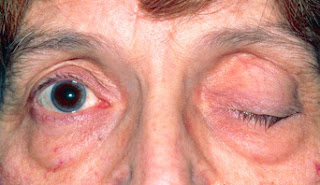Myasthenia Gravis is a chronic illness in which weakness and rapid fatigue of any of the muscles under your voluntary control is experienced. Characterized by severe weakness of certain muscle groups. In myasthenia gravis, certain muscles tire quickly, especially those of the face, lips, tongue, neck and throat. This condition is more common in women younger than 40 and in men older than 60. The probability that a person suffer from myasthenia gravis is 1 to 10,000 people. In general, patients with myasthenia have fallen heavy eyelids, fatigue, problems with facial mimicry, mastication and speech difficulties. Also, these patients have problems with upper and lower limb muscles.
The cause of myasthenia gravis is a disturbance in transfer of signal between nerves and muscles. The illness causes immune system to produce antibodies that disturbs some of the receptor sites for acetylcholine in affected muscles. As there are decreased receptors sites in affected muscle the muscle receives less amount of impulse which results in to inappropriate functioning and weakness.
Symptoms of Myasthenia Gravis:
Treatment of Myasthenia Gravis:
In addition to treatment, another way to improve the condition of the patient with myasthenia gravis is lifestyle changes. In other words, the patient must pay particular attention to rest, physical activity and weight, and go the doctor for physical therapy to increase muscle strength.
Nursing Care Plan for Myasthenia Gravis
Nursing Diagnosis : Disturbed Body Image related to ptosis , inability verbal communication
Goal :
Nursing Intervention and Rationale :
1. Assess the change of perception disorders and relationship with the degree of disability.
Rationale: Determining individual assistance in developing a treatment plan or intervention elections.
2. Identify the meaning of the loss or dysfunction of the client.
Rationale: Some clients can receive and manage multiple functions effectively with minimal adjustment, while others have difficulty comparing recognize and manage shortages.
3. Assist and encourage good maintenance and repair habits.
Rationale: Helps to improve self-esteem and feelings of control over one area of life.
4. Instruct the nearest person to allow clients, doing for himself as much as possible .
Rational : Turning back the feeling of independence and fosters self-esteem and affect the rehabilitation process.
5 . Collaboration : Experts refer to neuropsychology and counseling when indicated.
Rational : It can facilitate change an important role for the development of feelings.
The cause of myasthenia gravis is a disturbance in transfer of signal between nerves and muscles. The illness causes immune system to produce antibodies that disturbs some of the receptor sites for acetylcholine in affected muscles. As there are decreased receptors sites in affected muscle the muscle receives less amount of impulse which results in to inappropriate functioning and weakness.
Symptoms of Myasthenia Gravis:
- Drooping eyelids
- Double vision
- Difficulty in chewing
- Difficulties with speech
- Difficulty in breathing
- Difficulty in swallowing
- Weakness of extremities
Treatment of Myasthenia Gravis:
In addition to treatment, another way to improve the condition of the patient with myasthenia gravis is lifestyle changes. In other words, the patient must pay particular attention to rest, physical activity and weight, and go the doctor for physical therapy to increase muscle strength.
Nursing Care Plan for Myasthenia Gravis
Nursing Diagnosis : Disturbed Body Image related to ptosis , inability verbal communication
Goal :
- Increased client self-image
- Able to express or communicate with the people about the situation and the changes that are happening.
- Able to declare acceptance of the situation.
- Acknowledge and incorporate the changes into the concept of self in a way that accurately without the negative self-esteem.
Nursing Intervention and Rationale :
1. Assess the change of perception disorders and relationship with the degree of disability.
Rationale: Determining individual assistance in developing a treatment plan or intervention elections.
2. Identify the meaning of the loss or dysfunction of the client.
Rationale: Some clients can receive and manage multiple functions effectively with minimal adjustment, while others have difficulty comparing recognize and manage shortages.
3. Assist and encourage good maintenance and repair habits.
Rationale: Helps to improve self-esteem and feelings of control over one area of life.
4. Instruct the nearest person to allow clients, doing for himself as much as possible .
Rational : Turning back the feeling of independence and fosters self-esteem and affect the rehabilitation process.
5 . Collaboration : Experts refer to neuropsychology and counseling when indicated.
Rational : It can facilitate change an important role for the development of feelings.

I was diagnosed with Myasthenia Gravis in 2014, 2 years after they removed a tumor on my thymus. It's been an okay road. Had one flare which put me in the hospital 4 years ago and this previous year I have been in and out of the hospital trying to see which treatment can get me back feeling 100% again. Pyridostigmine bromide just makes me nauseous all day and didn't help my droopy eye or swallowing so I need to try something else which was natural herbs recommendation from multivitamincare. org This herbal treatment has successfully cure my MG and am 100% free ,I completed the herbal treatment program last year December and am very delighted i came across their website.it starts in the eyes and face then bulgar muscles , without treatment or the proper dosages of treatment it goes on to my limbs and then neck and breathing muscles but I can happily say that am free from MG after taking my chances to try natural herbs ,my neurologist was surprise after my result of being totally cured with herbal cure from the org.
ReplyDelete